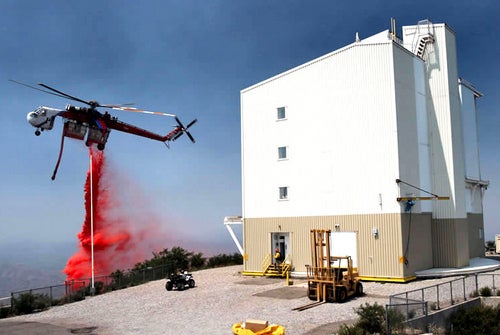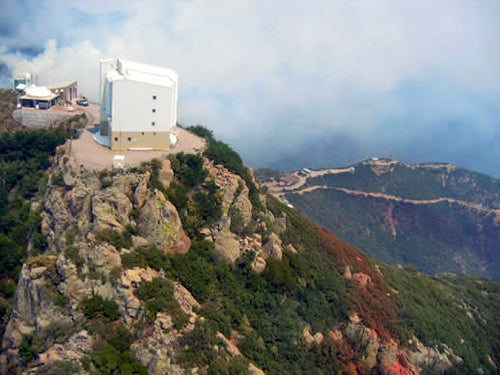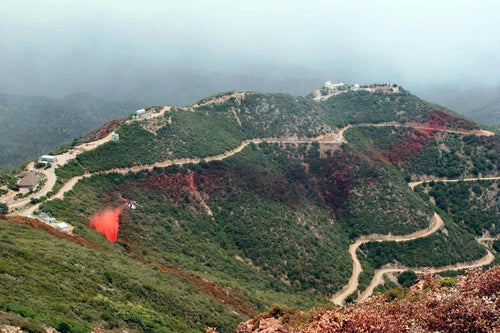Thunderstorm rains July 18
| What’s on Mt. Hopkins? |
| 6.5-meter (256-inch) MMT telescope
1.5-meter (60-inch) and 1.2-meter (48-inch) reflector telescopes 1.3-meter (51-inch) PAIRITEL (Peters Automated InfraRed Imaging Telescope) reflector, used for infrared observations — especially of gamma-ray bursts, supernovae, and other variable sources 10-meter optical gamma-ray telescope IOTA (Infrared-Optical Telescope Array) telescopes, used for optical and infrared interferometry HAT (Hungarian Automated Telescope) network of optical refractor telescopes, used for robotic observations of the night sky Equipment for the 12-meter VERITAS (Very Energetic Radiation Imaging Telescope Array System) optical gamma-ray telescope |
have effectively extinguished a fire half a mile from Mt. Hopkins, home of the Smithsonian’s Whipple Observatory and several smaller telescopes. More than 1,000 firefighters battled the blaze at its peak in an effort to protect the facility, which is valued at an estimated $100 million.
“We are very grateful to the U.S. Forest Service and the firefighting team for their efforts throughout the fire,” says Charles Alcock, director of the Harvard-Smithsonian Center for Astrophysics, which operates the observatory.
The MMT is the largest and most valuable telescope at the site. Recently upgraded with a new 6.5-meter mirror and a suite of powerful instruments, it hosts hundreds of researchers every year. The observatory is a joint venture between the Smithsonian Institution and the University of Arizona.
The first hint nature might undue what it started July 7, when lightning sparked the blaze in the Coronado National Forest, came Friday night, July 15. This was when a thunderstorm produced half an inch of rain, halting the fire’s advance at Jack Mountain half a mile east of Mt. Hopkins. Lightning from this storm also apparently knocked out the observatory’s all-sky camera.
Emilio Falco-Acosta, an astronomer at the Harvard-Smithsonian Center for Astrophysics, reported smelling smoke inside several of the instrument domes on Friday. “I expect there will be soot inside telescopes and instruments,” he says.
The following Monday, Steve Criswell, project manager for the observatory, told Astronomy, “You don’t see much smoke today. It has quieted down substantially.”
The same day, firefighters started backfires in Madera Canyon, a popular recreation area north of Jack Mountain. This practice uses controlled burns to consume fuel before the main fire reaches the area.
According to the U.S. Department of Agriculture’s Forest Service, the blaze was fully contained late July 21. It was located 25 miles (40 km) south of Tucson and burned more than 23,100 acres of the Coronado National Forest. Firefighters had the blaze fully contained July 21. The cost of fighting the fire now stands at $8.1 million, with 13 injuries were reported.
“Back-burning was our last resort because the backfires could have gotten out of control despite every safety precaution,” says Criswell. “Fire crews prepared to do it three separate times when the fire moved closer, but every time the fire died back again. Fortunately, we didn’t have to take that step.”
Helicopters spread fire-retardant slurry around the observatory in the event the blaze started a run up Mt. Hopkins, as it threatened to do before Friday’s rain. “There was also some trimming of vegetation around the facilities,” says Criswell, but he notes there’s little fuel to support a fire near the rocky summit. Moreover, he says, studies suggest the MMT building itself would fare well in a blaze. “In fact, this is the place we tell people to go in case of a fire. The dormitories and support buildings would be more threatened,” he says.
Observatory personnel were evacuated July 12 when the fire approached within a mile of the complex, although a few astronomers were allowed on the summit to check the status of equipment. All personnel returned July 20.












